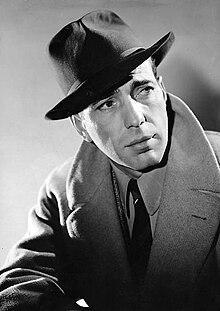
Back Humphrey Bogart Afrikaans Humphrey Bogart AN همفري بوغارت Arabic همفرى بوجارت ARZ Humphrey Bogart AST Humphrey Bogart Aymara Hamfri Boqart Azerbaijani هامفری بوقارت AZB Хамфри Богарт Bashkir Хамфры Богарт Byelorussian
Humphrey Bogart | |
|---|---|
 Bogart in 1940 | |
| Born | Humphrey DeForest Bogart December 25, 1899 New York City, U.S. |
| Died | January 14, 1957 (aged 57) Los Angeles, California, U.S. |
| Resting place | Forest Lawn Memorial Park, Glendale, California |
| Occupation | Actor |
| Years active | 1921–1956 |
| Political party | Democratic |
| Spouses | |
| Children | 2, including Stephen Humphrey |
| Mother | Maud Humphrey |
| Military career | |
| Branch | United States Navy |
| Years of service | 1918–1919 |
| Rate | Petty Officer 2nd Class |
| Service number | 1123062 |
| Unit | |
| Wars | World War I |
| Signature | |
Humphrey DeForest Bogart (/ˈboʊɡɑːrt/ BOH-gart;[1] December 25, 1899 – January 14, 1957), nicknamed Bogie, was an American actor. His performances in classic Hollywood cinema made him an American cultural icon.[2] In 1999, the American Film Institute selected Bogart as the greatest male star of classic American cinema.[3]
Bogart began acting in Broadway shows. Debuting in film in The Dancing Town (1928), he appeared in supporting roles for more than a decade, regularly portraying gangsters. He was praised for his work as Duke Mantee in The Petrified Forest (1936). Bogart also received positive reviews for his performance as gangster Hugh "Baby Face" Martin in William Wyler's Dead End (1937).
His breakthrough came in High Sierra (1941), and he catapulted to stardom as the lead in John Huston's The Maltese Falcon (1941), considered one of the first great noir films.[4] Bogart's private detectives, Sam Spade (in The Maltese Falcon) and Philip Marlowe (in 1946's The Big Sleep), became the models for detectives in other noir films. In 1947, he played a war hero in another noir, Dead Reckoning, tangled in a dangerous web of brutality and violence as he investigates his friend's murder, co-starring Lizabeth Scott. His first romantic lead role was a memorable one, as Rick Blaine, paired with Ingrid Bergman as Ilsa Lund in Casablanca (1942). Blaine was ranked as the fourth greatest hero of American cinema by the American Film Institute, and Blaine and Lund's romance the greatest love story in American cinema, also by the American Film Institute. Raymond Chandler, in a 1946 letter, wrote that "Like Edward G. Robinson when he was younger, all he has to do to dominate a scene is to enter it."[5]
44-year-old Bogart and 19-year-old Lauren Bacall fell in love during the filming of To Have and Have Not (1944). In 1945, a few months after principal photography for The Big Sleep, their second film together, he divorced his third wife and married Bacall. After their marriage, they played each other's love interest in the mystery thrillers Dark Passage (1947) and Key Largo (1948). Bogart's performances in Huston's The Treasure of the Sierra Madre (1948) and Nicholas Ray's In a Lonely Place (1950) are now considered among his best, although they were not recognized as such when the films were released.[6] He reprised those unsettled, unstable characters as a World War II naval-vessel commander in The Caine Mutiny (1954), which was a critical and commercial hit and earned him another Best Actor nomination. He won the Academy Award for Best Actor for his portrayal of a cantankerous river steam launch skipper opposite Katharine Hepburn's missionary in the World War I African adventure The African Queen (1951), another collaboration with Huston. Other significant roles in his later years included The Barefoot Contessa (1954) with Ava Gardner and his on-screen competition with William Holden for Audrey Hepburn in Sabrina (1954).
A heavy smoker and drinker, Bogart died from esophageal cancer in January 1957. Four films he starred in, Casablanca, The Maltese Falcon, The Treasure of the Sierra Madre and The African Queen, made the American Film Institute's 1998 list of the greatest American movies of all time, with Casablanca ranked second. Regarding her husband's enduring popularity, Bacall later said, "There was something that made him able to be a man of his own, and it showed through his work. There was also a purity, which is amazing considering the parts he played. Something solid too. I think as time goes by, we all believe less and less. Here was someone who believed in something."[7]
- ^ "Bogart." Random House Webster's Unabridged Dictionary. Retrieved: March 13, 2014.
- ^ Sragow, Michael. "Spring Films/Revivals; How One Role Made Bogart Into an Icon". The New York Times, January 16, 2000. Retrieved: February 22, 2009.
- ^ "AFI'S 100 Years...100 Stars: AFI's 50 Greatest American Screen Legends". American Film Institute. Archived from the original on October 10, 2018. Retrieved March 15, 2019.
- ^ Sklar, Robert (1993). Film: An International History of the Medium. London, England: Thames and Hudson. ISBN 978-0-13-034049-8.
- ^ Chandler, Raymond (1981). Selected Letters. College Trustees, Ltd.
- ^ Steven Jay Scheider, Ed. pp. 244 and 263; 1001 Movies You Must See Before You Die, Quintessence Editions Limited, 2003. pp. 244 and 263. ISBN 0-7641-5907-0.
- ^ Bogdanovich, Peter (September 1, 1964). "Bogie in Excelsis". Esquire.